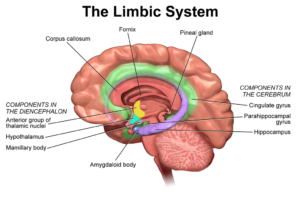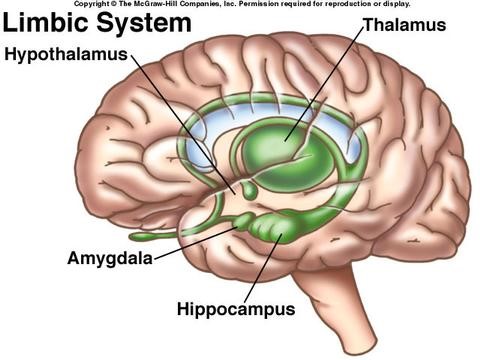IMPORTANCE OF THE LIMBIC SYSTEM IN HUMAN & ANIMALS
The term limbic system has often been taken to be synonymous with emotional brain.The limbic system is a set of structures of the brain. The limbic system is a network of structures located beneath the cerebral cortex. This system is important because it controls some behaviors that are essential to the life of all mammals (finding food, self-preservation). Interestingly, the same structures found in the human limbic system can also be found in the brains of evolutionary ancient animals such as the alligator. In the alligator, the limbic system is heavily involved in smell and plays an important role in defending territory, hunting and eating prey. In humans, the limbic system is more involved in motivation and emotional behaviors.
These structures cover both sides of the thalamus, right under the cerebrum. It is not a separate system, but a collection of structures from the cerebrum, diencephalon, and midbrain. It supports many different functions, including emotion, behaviour, motivation, long-term memory, and olfaction.[1] It is the part of the brain involved when it comes to behaviours we need for survival: feeding, reproduction and caring for our young, and fight or flight responses.
While the structures in this highly developed part of the brain interconnect, research has shown that the amygdala, a small almond-shaped structure deep inside the brain, and the hippocampus, a tiny, seahorse-shaped structure, seem to be the main areas involved with emotions. The amygdala connects with the hippocampus as well as the medial dorsal nucleus of the thalamus. These connections enable it to play an important role in the mediation and control of major activities like friendship, love and affection and on the expression of mood. The hypothalamus, particularly its median part, has been identified as a major contributor to the production of loud, uncontrollable laughter.
- It combines higher mental functions and primitive emotion into a single system often referred to as the emotional nervous system. It is not only responsible for our emotional lives but also our higher mental functions, such as learning and formation of memories. The limbic system is the reason that some physical things eg eating, seem so pleasurable to us, and the reason why some medical conditions, such as hypertension, are caused by mental stress.
- There are several important structures within the limbic system: the amygdala, hippocampus, thalamus, hypothalamus, basal ganglia, and cingulate gyrus.
- The limbic system is among the oldest parts of the brain in evolutionary terms: it can be found in fish, amphibians, reptiles and mammals.
- The pleasure center is located in the limbic system. It is involved in sexual arousal and in the “high” derived from certain recreational drugs.
Important Limbic Structures
All the components of the limbic system work together to regulate some of the brain’s most important processes. The components are listed below:

The Amygdala
- Small almond-shaped structure; there is one located in each of the left and right temporal lobes. Known as the emotional center of the brain, the amygdala is involved in evaluating the emotional valence of situations (e.g., happy, sad, scary). It helps the brain recognize potential threats and helps prepare the body for fight-or-flight reactions by increasing heart and breathing rate. The amygdala is also responsible for learning on the basis of reward or punishment.
- Due to its close proximity to the hippocampus, the amygdala is involved in the modulation of memory consolidation, particularly emotionally-laden memories. Emotional arousal following a learning event influences the strength of the subsequent memory of that event, so that greater emotional arousal following a learning event enhances a person’s retention of that memory.
The Hippocampus
- Found deep in the temporal lobe, and is shaped like a seahorse. It consists of two horns curving back from the amygdala. Psychologists and neuroscientists dispute the precise role of the hippocampus, but generally agree that it plays an essential role in the formation of new memories about past experiences.
The Thalamus and Hypothalamus
- Both associated with changes in emotional reactivity. The thalamus (sensory “way-station” for the rest of the brain) is primarily important due to its connections with other limbic-system structures. The hypothalamus is a small part of the brain located just below the thalamus on both sides of the third ventricle. Lesions of the hypothalamus interfere with several unconscious functions (such as respiration and metabolism) and some so-called motivated behaviors like sexuality, combativeness, and hunger. The lateral parts of the hypothalamus seem to be involved with pleasure and rage, while the medial part is linked to aversion, displeasure, and a tendency for uncontrollable and loud laughter.
The Cingulate Gyrus
- Located in the medial side of the brain next to the corpus callosum. Its frontal part links smells and sights with pleasant memories of previous emotions. This region also participates in our emotional reaction to pain and in the regulation of aggressive behavior.
The Basal Ganglia
- A group of nuclei lying deep in the subcortical white matter of the frontal lobes that organizes motor behavior.
Limbic System Disorders
Because subparts of the limbic system ultimately regulate important aspects of our conscious and unconscious patterns (including our emotions, perceptions, relationships, behaviors and motor control) it’s easy to see why damage to this region can cause serious problems.
Disorders or behaviors that are related to limbic system dysfunction/damage (eg traumatic injuries or aging) include:
- Disinhibited behavior: Person doesn’t consider the risk of behaviors and ignores social conventions/rules.
- Increased anger and violence: Commonly tied to amygdala damage.
- Hyperarousal: Amygdala damage, or damage to parts of the brain connected to the amygdala, can cause increased fear and anxiety. Anxiety disorders are sometimes treated with drugs that target areas of the amygdala to decrease fear-based emotions.
- Hypoarousal: Can cause low energy or lack of drive and motivation.
- Hyperorality/Kluver-Bucy Syndrome: This is characterized by amygdala damage that can lead to increased drive for pleasure, hypersexuality, disinhibited behavior and insertion of inappropriate objects in the mouth.
- Appetite dysregulation: Destructive behaviors tied to hyperorality or thalamus dysfunction can include overeating, binge eating or emotional eating.
- Trouble forming memories: Hippocampal damage can include short-term or long-term memory loss. Learning is often greatly impacted by hippocampal damage, since it depends on memory.
- Cognitive disorders eg Alzheimer’s disease: Research shows that people with Alzheimer’s and memory loss usually have experienced damage to the hippocampus. This causes memory loss, disorientation and changes in moods. Some of the ways that the hippocampus can become damaged include free radical damage/oxidative stress, oxygen starvation (hypoxia), strokes or seizures/epilepsy.
Puberty and the Limbic System
Puberty is the beginning of major changes in the limbic system
- Part of the limbic system, the amygdala is thought to connect sensory information to emotional responses. Its development, along with hormonal changes, may give rise to newly intense experiences of rage, fear, aggression (including toward oneself), excitement and sexual attraction.
- Over the course of adolescence, the limbic system gradually comes under greater control of the prefrontal cortex (an area associated with planning, impulse control and higher order thought).
- As additional areas of the brain start to help process emotion, older teens gain some equilibrium and have an easier time interpreting others. But until then, they often misread others eg teachers and parents.
Compiled & Shared by- Team, LITD (Livestock Institute of Training & Development)
Image-Courtesy-Google
Reference-On Request.


